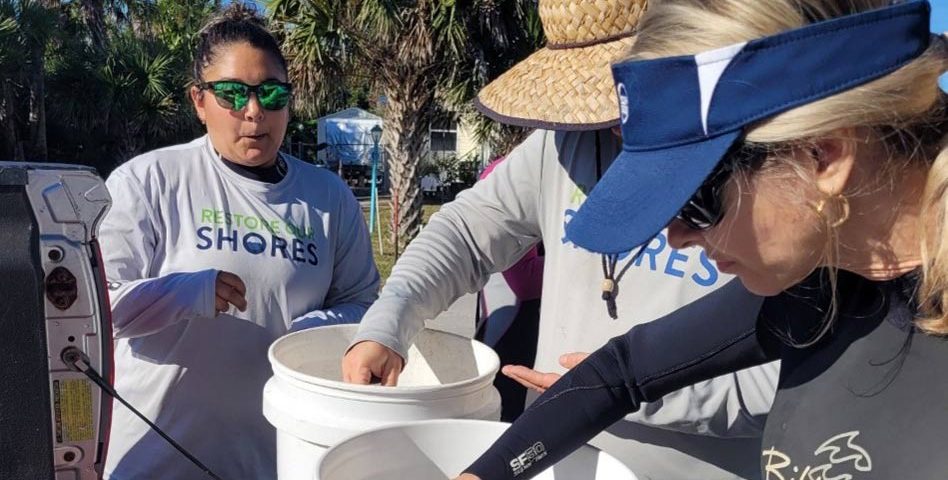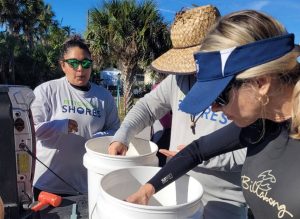District shares series of articles on science behind algal blooms, continues partnerships to address causes

District staff and staff from the Restore our Shores conservation team at Brevard Zoo inspect buckets of young clams before distributing the clams in the Indian River Lagoon as part of a District cost-share project to enhance clam repopulation.
PALATKA, Fla., Feb. 8, 2022 — St. Johns River Water Management District scientists and partners are sharing data, analyses and insights to help improve water quality and overall health of the Indian River Lagoon region and other water bodies through a series of articles in a scientific journal. The first article with a District scientist as lead author has been published in the Marine Ecosystem Ecology section of the journal “Frontiers in Marine Science.”

District staff and staff from the Restore our Shores conservation team at Brevard Zoo inspect buckets of young clams before distributing the clams in the Indian River Lagoon as part of a District cost-share project to enhance clam repopulation.
The scientific articles now going to publication build off both long-term data and studies conducted in response to a 2011 “superbloom” of phytoplankton, and they also incorporate new scientific techniques.
“I’m proud of the commitment by our District scientists and experts as they tackle these complex issues that affect not only the Indian River Lagoon, but all the waterways that we are working to restore and protect,” says St. Johns River Water Management District Executive Director Mike Register. “Many of our staff members have built careers working in and along the lagoon and have a personal interest in helping to see the lagoon restored to better health.”
The series of 24 articles is expected to be completed in 2022, and it represents one element in the District’s continuing collaboration with many partners to understand the changes stemming from the superbloom in the 156-mile-long estuary along Florida’s east coast. District scientists are the lead author or co-author on 13 of the 24 peer-reviewed journal articles.
The recently published article, “Seagrass in a changing estuary, the Indian River Lagoon, Florida, United States,” examines how the distribution and abundance of seagrasses in the lagoon respond to salinity, temperature and availability of light. Other articles currently being written for the series cover topics such as changes in drift macroalgae, phytoplankton dynamics and use of different forms of nutrient, changes in fish populations, use of remote sensing to identify “hot spots” for phytoplankton blooms, and influences of tributaries on water quality.
“Our board is committed to supporting staff in their work to identify conditions that impact the lagoon, develop solutions and implement projects to restore this waterway,” says Governing Board Member Cole Oliver of Merritt Island. “The funding from Gov. DeSantis and the Legislature in the past two years helps to further the work that we can do in collaboration with local partners.”
Future articles will be shared through the District’s website as they are published. Additional information about the District’s ongoing work in the lagoon region is available at www.sjrwmd.com/waterways/indian-river-lagoon.

